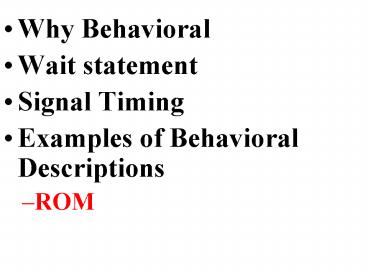Why Behavioral PowerPoint PPT Presentation
Title: Why Behavioral
1
- Why Behavioral
- Wait statement
- Signal Timing
- Examples of Behavioral Descriptions
- ROM
2
VHDL Behavioral Descriptions
- The process concept
- Wait statements and time modeling
- Behavioral versus data-flow descriptions
- Modeling of basic hardware components
- Mixed descriptions
3
VHDL Behavioral Descriptions
- VHDL data-flow descriptions model simple devices
whose outputs are always a function of their
inputs. - A more general capability is required to model
devices with internal (hidden) state information. - A technique is required to describe device
behavior in algorithmic (sequential) terms. - The process statement provides a compact
representationfor arbitrary deterministic
behavior of hardware components. - The subprogram encapsulates a sequence of
sequential statements.
4
Why Behavioral Description?
- Designers can first concentrate on the behavior
of a system, and then work on different
implementations later. - Manufacturers can release a functionality
definition without revealing proprietary details
of implementation. - Support top-down design methodologies.
- Support multi-level simulation
5
Processes
- A process consists of a set of sequential
statements, which are executed one by one
according to their textual order. - The sequential statements are similar to those in
a high-level programming language- Variable
assignment statements- If and case statements-
Loop statements- Procedure call and return
statements - Unique to VHDL- Signal assignment statements-
Wait statements- Assertion statements
6
Processes
- EXAMPLE
- architecture behavior of E is begin
P1 process variable V Natural 0
begin for i in 1 to 100 loop
V V 1 end loop - S lt V after 10ns
wait for 20ns end process P1...end
behavior
7
Process Semantics
- All processes start execution at simulation time
zero. - A process stops execution when it reaches a wait
statement. - The process resumes when the conditions specified
by the wait statement are met. - When the last statement of a process is executed
the process begins again at the first statement.
8
Process Semantics
- If a process never waits then it will loop
forever. - A process which is being executed is said to be
active otherwise the process is said to be
suspended. - Process statements which do not assign values to
signals are said to be passive. - A passive process has no outputs (it does not
assign to any signals) and, therefore, cannot
cause the activation of another process. - Passive process can be placed in the entity
declaration.
9
Process Semantics
Example of process semantics
10
The Wait Statements
11
The Wait Statements
- Wait statements are used to control the change of
state of processes. - We can also use a sensitivity list to define a
set of signals which a process is always
sensitive to. - In this case, it is illegal to include any wait
statements in the process (or in subprograms
called by the process).
12
The Wait Statements
13
Signal Timing
- The three models of time delay are applicable
here to the behavioral description. - - Signals are never assigned to directly.
What will be the result?
14
The Simulation Cycle
- If no driver is active, the simulation time
advances to the next time at which a driver
becomes active or a process times out on a wait
for - Processes that have timed out are the initial
members of a list of pending processes - Each active explicit signal (other than implicit)
in the model is updated events may occur on
signals as a result - Each implicit signal (such as GURAD, DELAYED,
- STABLE, QUIET, or TRANSACTION) in the
model - is updated events may occur on signals as
a result
15
The Simulation Cycle
- Every process waiting on a signal which has just
experienced - an event is added to the list of pending
processes - Each pending process is executed until it
suspends - Repeat the cycle
- Simulation is complete when the simulation time
has advanced to the value time'high
16
Process Communication
- Processes can communicate with each other via
signals (not variables). - Signals are used to transmit information between
processes. - If there is more than one parallel assignment to
the same signal the signal must be declared as a
resolved signal
17
Process Communication - zoom
18
Process Communication - zoom
19
Behavioral vs. Data-flow Descriptions
- A concurrent signal assignment statement
corresponds to a process
20
An example of Behavioral Description ROM
- Behavioral description of a memory board
21
An example (contd)
22
An example (contd - zoom)
23
An example (contd - zoom)
24
Variable Assignment
- In VHDL 87, variables can only be declared in a
process or a subprogram. - A variable assignment will take effect
immediately. - A variable will retain its value throughout the
simulation if it is declared in a process. - Variables declared in subprograms are
reinitialized whenever the subprogram is called. - Ex.
25
Sources
- Krzysztof Kuchcinski

